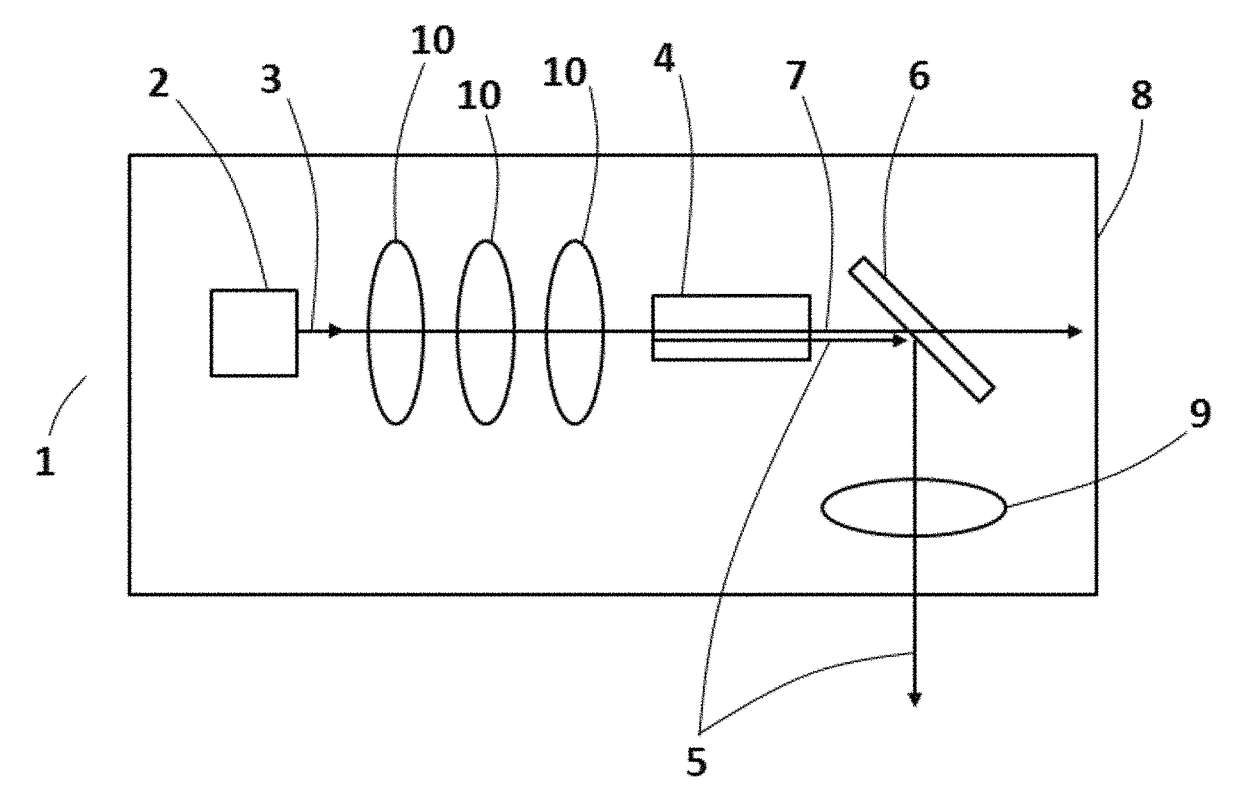Light source configured for stabilization relative to external operating conditions
a technology of stabilization and light source, applied in the direction of optical resonator shape and construction, semiconductor laser, instruments, etc., can solve the problems of maintaining effective power output, adding etc., and achieves the effects of low cost, good efficiency, and complexity and size to the overall devi
- Summary
- Abstract
- Description
- Claims
- Application Information
AI Technical Summary
Benefits of technology
Problems solved by technology
Method used
Image
Examples
example 3
hich Makes Use of Residual Blue Light to Heat BBO Crystal
[0175]A third example of this invention is now disclosed. The third example is similar to the second example and common features may not be repeated. In this third example, which is illustrated in FIG. 20, the device 1 includes a light absorbing component 50 which partially or fully absorbs light with the wavelength of the source light 3 emitted by the laser light source 2. The light absorbing component 50 is attached to the nonlinear optical component 4, or alternatively it may be attached to the housing 8 close to, or otherwise in thermal contact with, the nonlinear optical component.
[0176]The light absorbing component 50 may be a coating of a light absorbing material applied to the nonlinear optical component or housing, such as for example a metal oxide layer applied by anodising or painting. The component may be a separate piece which is attached to the nonlinear optical component 4 or housing 8, for example by using a sc...
example 4
to Reduce Change in Beam Direction and / or Position
[0179]A fourth example of this invention is now disclosed. The fourth example is similar to the first example and common features may not be repeated. In this fourth example, which is illustrated in FIG. 21, the device 1 includes one or more optical components 60 which reduce the variation in direction or position of the output light beam 5 when operating conditions are changed. As described above, a variation in the operating conditions of a device according to any of the other examples in this disclosure may result in a change in the direction of the frequency-converted output light (e.g. second harmonic light) propagating out of the nonlinear optical component 4, for example if any change in operating condition causes a change in the wavelength of the source light 3 emitted by the laser light source 2. Experimental data showing this effect is displayed in FIG. 13. This data shows that the position of the frequency-converted output...
example 5
h Wavelength Stabilising Component
[0184]A fifth example of this invention is now disclosed. The fifth example is similar to the second example and common features may not be repeated. In this fifth example, which is illustrated in FIG. 22, the laser device 1 includes a wavelength stabilising component 70. The wavelength stabilising component 70 is configured to reduce a variation in the wavelength of the source light 3 emitted from the laser light source 2 when operating conditions are changed.
[0185]In this example the wavelength stabilising component is a surface diffraction grating, preferably a holographic diffraction grating, with a surface including an aluminium layer and with 3600 lines per mm. However, similar performance may be obtained using a grating with a different number of lines per mm, a grating with a different surface material layers (e.g. silver) or a different grating type (e.g. a ruled diffraction grating or volume Bragg grating). Furthermore, similar performance...
PUM
 Login to View More
Login to View More Abstract
Description
Claims
Application Information
 Login to View More
Login to View More - R&D
- Intellectual Property
- Life Sciences
- Materials
- Tech Scout
- Unparalleled Data Quality
- Higher Quality Content
- 60% Fewer Hallucinations
Browse by: Latest US Patents, China's latest patents, Technical Efficacy Thesaurus, Application Domain, Technology Topic, Popular Technical Reports.
© 2025 PatSnap. All rights reserved.Legal|Privacy policy|Modern Slavery Act Transparency Statement|Sitemap|About US| Contact US: help@patsnap.com



